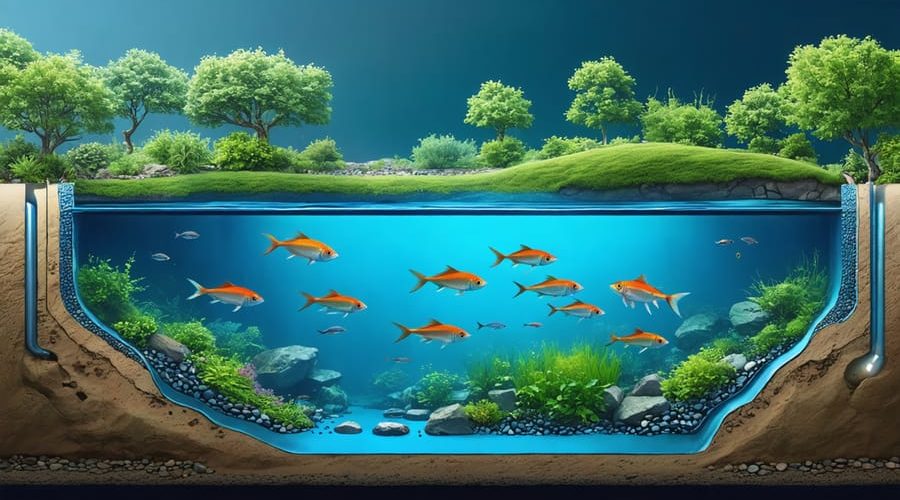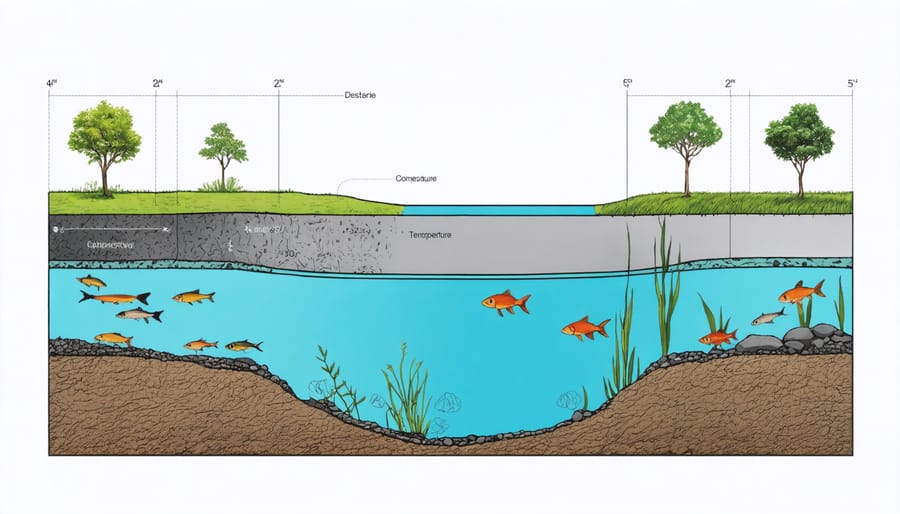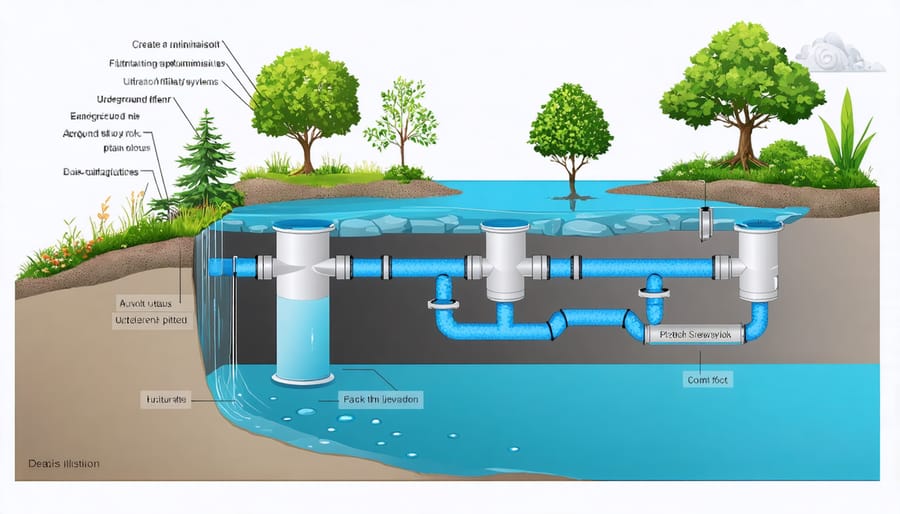
Underground Fish Ponds: Your Secret to Year-Round Fish Breeding Success
Dive into the fascinating world of underground fish ponds, where ancient wisdom meets modern aquaculture innovation. These subterranean aquatic environments offer a revolutionary approach to fish breeding, combining natural temperature regulation with efficient space utilization. Unlike traditional above-ground ponds, underground systems maintain consistent water temperatures year-round, creating optimal conditions for fish growth and reproduction while protecting your aquatic livestock from predators and harsh weather extremes.
Picture a thriving ecosystem hidden beneath your backyard’s surface, where fish flourish in controlled conditions while contributing to a sustainable, self-sufficient food system. Underground fish ponds represent the perfect fusion of practical functionality and innovative design, offering benefits that extend far beyond conventional aquaculture methods. Whether you’re a homesteader seeking food independence, an aquaculture enthusiast exploring new breeding techniques, or a property owner looking to maximize space efficiency, underground fish ponds provide a compelling solution that’s both productive and environmentally conscious.
These remarkable systems have transformed fish breeding practices worldwide, offering a glimpse into the future of sustainable aquaculture while drawing on time-tested principles of water management and fish husbandry.
Why Underground Fish Ponds Excel at Fish Breeding
Temperature Stability Benefits
One of the most remarkable benefits of underground fish ponds is their natural temperature stability. Unlike above-ground ponds that are exposed to direct sunlight and air temperature fluctuations, underground ponds maintain a more consistent temperature throughout the year. This is because the earth acts as a natural insulator, keeping the water cooler during hot summer months and warmer during winter.
The soil surrounding an underground pond typically stays at a steady temperature of around 50-60°F (10-15°C) at depths of 4 feet or more. This natural insulation helps protect your fish from sudden temperature changes that can cause stress and health issues. During summer, when surface ponds might heat up dramatically, underground ponds remain refreshingly cool. In winter, the surrounding earth prevents the water from freezing completely, providing a safe haven for your fish.
This temperature stability is particularly beneficial for fish species that are sensitive to temperature fluctuations, making underground ponds an excellent choice for year-round fish keeping in various climates. It also helps reduce the need for artificial heating and cooling systems, making these ponds more energy-efficient and environmentally friendly.

Natural Protection Features
Underground fish ponds offer exceptional natural protection for your aquatic pets, making them an ideal choice for fish keeping. The earth surrounding the pond acts as a natural insulator, maintaining stable water temperatures throughout the year. This temperature stability is crucial for fish health and helps them thrive even during extreme weather conditions.
Being below ground level also provides excellent protection from predators like herons, raccoons, and cats. The steep sides and lower visibility make it difficult for these animals to spot and reach your fish. Additionally, the surrounding landscape can be designed with strategic plantings and rocks to create further barriers while enhancing the pond’s natural appearance.
During harsh weather events like storms or high winds, underground ponds offer a safe haven for fish. The below-grade location prevents water from being blown out of the pond and protects against debris that might otherwise fall in. In winter, the earth’s natural insulation helps prevent the pond from freezing solid, providing fish with a deeper, safer zone to overwinter. This natural protection system makes underground ponds particularly appealing for fish keepers in areas with extreme weather conditions.
Designing Your Underground Breeding Pond
Depth and Size Requirements
When planning your underground fish pond, getting the dimensions right is crucial for healthy fish development. For most home ponds, a minimum depth of 4 feet is recommended, though 5-6 feet is ideal for breeding purposes. This depth ensures stable water temperatures and gives fish enough space to establish natural breeding territories.
The surface area of your pond should be at least 100 square feet to support a small breeding population. For optimal results, consider a pond size of 200-300 square feet, which provides ample space for fish to grow and breed comfortably. Remember that larger ponds are more stable and easier to maintain than smaller ones.
Shape matters too – incorporate both shallow and deep zones in your design. The shallow areas (1-2 feet deep) should cover about 20% of the total surface area, serving as spawning grounds and providing space for aquatic plants. The deeper sections should make up the remaining 80%, giving fish plenty of room to swim and take shelter.
When excavating, create gradual slopes rather than steep walls. A slope ratio of 3:1 (horizontal:vertical) is ideal for stability and safety. Include at least one shelf around the perimeter, about 12-18 inches deep, for marginal plants and easier maintenance access. This stepped approach also helps prevent erosion and provides natural-looking transitions between different depth zones.
Filtration and Water Flow Systems
A well-designed perfect filtration system is crucial for maintaining a healthy underground fish pond. The primary components you’ll need are a reliable pump, mechanical filter, and biological filter. Start by installing a submersible pump that’s powerful enough to circulate your pond’s entire water volume at least once every two hours.
For mechanical filtration, use a pre-filter or skimmer to catch larger debris like leaves and twigs before they can decompose. This helps reduce the workload on your biological filter and keeps water clearer. Position the intake at the pond’s deepest point to ensure proper water movement throughout.
Biological filtration is where beneficial bacteria break down harmful waste products. Consider using a combination of filter media like bio-balls, filter mats, and lava rock to provide plenty of surface area for these helpful bacteria to colonize. Install the biological filter slightly above ground level to make maintenance easier.
Create a gentle water flow pattern that reaches all areas of your pond while avoiding strong currents that might stress your fish. Adding strategically placed air stones will help maintain optimal oxygen levels, especially in deeper sections where circulation might be limited.
Remember to include easy-access points for maintenance and cleaning. Regular system checks and filter cleaning will keep your underground pond ecosystem thriving year-round.

Creating the Perfect Breeding Environment
Water Quality Management
Maintaining proper water quality is crucial for creating a thriving ecosystem in your underground fish pond. Since these ponds have limited natural water exchange, monitoring and managing water parameters becomes even more important. Regular testing of pH levels, ammonia, nitrites, and dissolved oxygen will help you stay on top of your pond’s health.
The ideal pH range for most pond fish is between 6.5 and 8.5. Test your water weekly using a reliable testing kit, and make adjustments gradually if needed. Installing a proper filtration system, including mechanical and biological filters, helps maintain water clarity and breaks down harmful waste products.
Temperature stability is another advantage of underground ponds, but you’ll still need to monitor it regularly. Most pond fish thrive in temperatures between 50-75°F (10-24°C). Consider installing a thermometer to track these changes throughout the seasons.
Following essential health management strategies like regular water changes (about 10-15% monthly) helps prevent the buildup of harmful compounds. Adding beneficial bacteria supplements can boost your pond’s natural filtration capacity and help maintain optimal water conditions.
Don’t forget to remove debris regularly and maintain proper plant coverage to help balance nutrient levels. Floating plants can provide shade and help regulate water temperature, while submerged plants act as natural filters. With consistent monitoring and maintenance, your underground pond will provide a healthy environment for your fish to thrive.
Breeding Zones and Hiding Spots
Creating successful breeding zones in your underground fish pond requires careful planning and strategic design. Fish need dedicated spaces where they can lay eggs and protect their young from predators. The key is to incorporate various depths and textures that mimic their natural breeding environments.
Start by establishing shallow shelves or ledges around the pond’s perimeter, ideally 6-12 inches deep. These areas warm up quickly in spring, making them perfect for spawning. Add specially designed breeding techniques like installing breeding mats or synthetic grass where fish can deposit their eggs.
Creating hiding spots is equally important for protecting both eggs and young fish. Include caves, hollow logs, or purpose-built fish shelters at different depths. Large rocks arranged in clusters provide excellent coverage, while aquatic plants like water lilies offer natural sanctuary. Position these features away from direct water flow to prevent eggs from being washed away.
Consider installing a separate breeding area or pocket connected to the main pond. This protected space allows you to control conditions better and monitor the breeding process more closely. Use fine-mesh barriers to keep adult fish from accessing these nursery zones while allowing water circulation.
Remember to maintain plenty of oxygen-rich areas near breeding zones by incorporating air stones or gentle water movement. The right combination of shelter, protection, and proper water conditions will significantly increase your success rate in fish breeding while creating a thriving ecosystem in your underground pond.

Common Challenges and Solutions
Maintenance Access
Maintaining an underground fish pond doesn’t have to be a hassle if you plan for easy access from the start. Install wide, stable steps leading down to your pond’s edge, ensuring they’re slip-resistant and well-lit for safety during evening maintenance. Consider building a small deck or platform around part of the pond’s perimeter to create a stable work area.
Strategic placement of maintenance ports is crucial. Install access points for filters, pumps, and other equipment where they can be easily reached without awkward stretching or climbing. Place electrical outlets in weatherproof boxes at convenient locations, but always keep them elevated and away from water splash zones.
Include a shallow shelf or ledge around the pond’s interior edge, about 18-24 inches below the surface. This serves as a standing area during maintenance and makes it easier to reach deeper areas of the pond. For larger ponds, consider installing multiple access points rather than trying to maintain everything from one location.
Keep essential tools nearby by building a small, weatherproof storage cabinet close to the pond. Stock it with nets, water testing kits, and basic maintenance supplies. If possible, install a water source close to the pond for easy water changes and top-ups.
Remember to leave enough space around the pond’s perimeter for maintenance equipment like nets with long handles or pond vacuums. Regular maintenance becomes much more manageable when you can easily reach all areas of your pond.
Winter Preparations
As winter approaches, it’s crucial to prepare your underground fish pond for the colder months ahead. Start by checking the pond’s insulation – one advantage of underground ponds is their natural temperature stability, but additional protection may be needed in severe climates.
Remove fallen leaves and debris regularly during autumn to prevent them from decomposing and affecting water quality. Consider installing a pond net to catch falling leaves before they reach the water. Trim back any surrounding aquatic plants, removing dead foliage that could decay in the water.
If you live in an area where the pond might freeze, install a de-icer or pond heater to maintain a small ice-free area. This allows for proper gas exchange and prevents toxic gases from building up under the ice. However, avoid breaking ice directly on the pond surface, as this can shock your fish.
Adjust your fish feeding routine as temperatures drop. Fish metabolism slows significantly in cold water, so reduce feeding amounts and switch to winter-specific food when water temperatures fall below 50°F (10°C). Eventually, stop feeding altogether when temperatures drop below 39°F (4°C).
Check your filtration system and consider reducing its flow rate during winter. Some pond owners choose to remove pumps entirely, while others maintain minimal circulation to prevent stagnation. Whatever you decide, ensure your equipment is properly maintained and protected from freezing.
Underground fish ponds offer a unique and rewarding approach to fish breeding that combines practicality with natural beauty. By maintaining consistent water temperatures and providing protection from predators, these hidden sanctuaries create optimal conditions for successful breeding programs. The reduced maintenance requirements and lower operating costs make them an attractive option for both hobbyists and serious breeders alike.
The natural insulation of the earth not only helps regulate temperature but also contributes to a more sustainable and environmentally friendly setup. Your fish will thrive in an environment that closely mimics their natural habitat, leading to healthier breeding cycles and stronger offspring. The aesthetic appeal of an underground pond can’t be understated – it seamlessly integrates with your landscape while providing a peaceful retreat for your aquatic friends.
Whether you’re a beginner looking to start your first breeding project or an experienced enthusiast seeking to expand your capabilities, an underground fish pond could be the perfect solution. The initial investment in construction is offset by long-term benefits: reduced energy costs, minimal water loss through evaporation, and enhanced protection for your valuable fish stock.
Consider taking the plunge into underground pond breeding – it’s a rewarding venture that combines the best of natural ecosystems with modern breeding techniques. Your fish will thank you, and you’ll enjoy the satisfaction of creating a thriving, sustainable breeding environment right in your own backyard.
